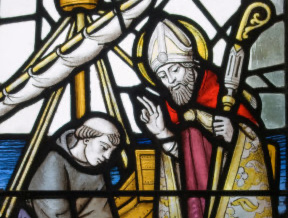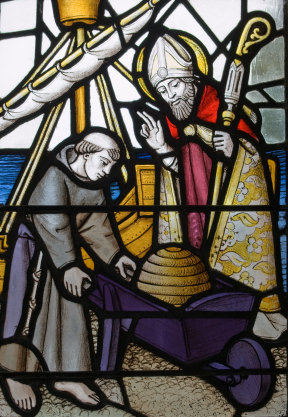
With St David’s Day having just been celebrated in Wales and many other places around the world, DAVID ADAMS takes a look at the life of Wales’ most famous saint…
The patron saint of Wales, St David – known in Welsh as Dewi Sant – was apparently a key figure in the Celtic church of the 6th century.
With little real evidence of the details of his life, David’s story has been the subject of much speculation with the most fulsome version of his legendary life contained in a hagiography, Life of St David, written by Rhygyfarch, son of the Bishop of St David’s, in the 11th century.

BLESSING: A Victorian stained-glass window showing St David blessing a hive of bees as they are about to be shipped to Ireland. PICTURE: © Amanda Lewis
David is understood to have been born sometime in the late 5th or early 6th century. The son of a prince who is said to have either seduced or raped the aristocratic St Non (who went on to become a nun), he was born on a clifftop in a violent storm (now the site of the Chapel of St Non in Pembrokeshire).
He is believed to have been a student of St Paulinus (he apparently cured him of blindness when he made the sign of the cross in front of him) and rose to become a noted preacher and evangelist, founding churches in Wales, Cornwall and Brittany.
Later to become a great church leader (he’s ascribed by some as being the Archbishop of Wales), David is said to have gone on pilgrimages to both Rome and Jerusalem. St David’s Cathedral in Wales now stands on the site of a monastery he founded (then known as Menevia).
Having committed himself to a life of asceticism, David is understood to have advocated the same among his followers – a move which apparently was not always popular among the monks who, so the story goes, once tried to poison him (they apparently also gave him the name ‘Dwei Ddyfrwr’ or ‘David the Waterman’). He was also apparently active in suppressing the Pelagian heresy.
It’s said that he died somewhere between 589-601 on 1st March – the day now celebrated as St David’s Day, a national festival (though not yet a public holiday) among the Welsh – before being buried in what is now St David’s Cathedral (his shrine there was a popular place of pilgrimage in the Middle Ages).
The most famous of the miracles associated with St David tells of how, when he was preaching to a huge crowd, the ground rose up beneath him, creating a hill so everyone could see him.
St David was canonised in 1120 by Pope Callactus II and pilgrims started to make their way to St David’s in Wales.
St David is often depicted with a dove which symbolises the Holy Spirit through which he was given the gift of public preaching. These days people wear the image of a leek or a daffodil to mark St David’s Day, although the tradition of wearing a daffodil, at least, only dates from the early 20th century.
SOURCES AND FURTHER INFORMATION:
~ www.bbc.co.uk/religion/religions/christianity/saints/david_1.shtml
~ www.bbc.co.uk/news/uk-wales-12602857
~ http://sucs.org/~rhys/stdavid.html
~ www.stdavidscathedral.org.uk
~ www.stdavidsday.org/stdavid/index.php/History/who-was-stdavid.html






